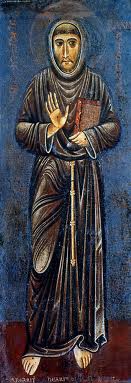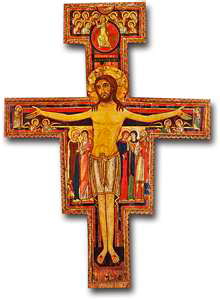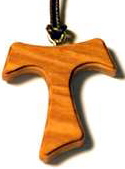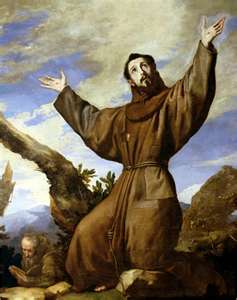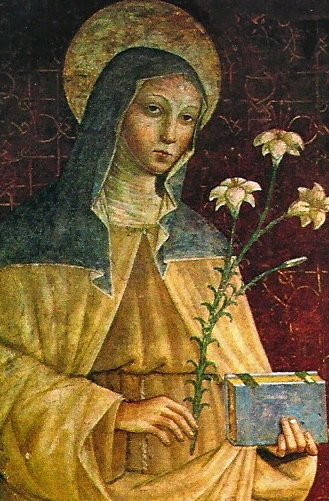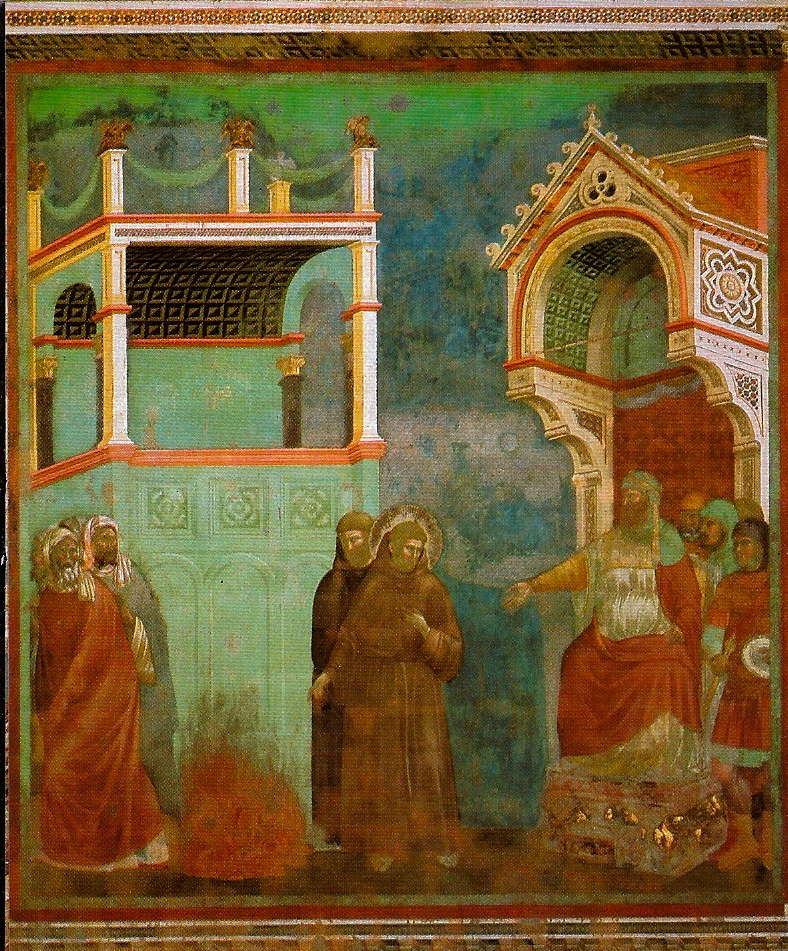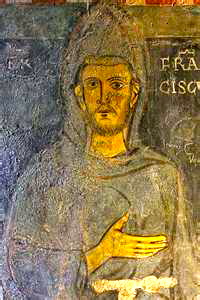A Biographical Sketch
His Birth
Francis was born in Assisi, Italy in 1182. His parents were Pietro Bernardone, a very prosperous cloth merchant, and Lady Pica. When the child was born, Pietro was away on business. Pica named the boy John (Giovanni), after Saint John the Baptist. When Pietro returned home he began calling the child Francis (Francesco), which means Frenchman.
Pietro Bernardone made frequent journeys into France to purchase cloth. It is likely that the young Francis, being the oldest child, accompanied his Father on at least some of these journeys. Pica may have been French, and perhaps this is why Francis became so influenced by the French language and culture. He loved tales of knights in armor and troubadours with songs of love and adventure.
The Bernardone family was at the pinnacle of the rising merchant class of Assisi. It is believed that the money behind Pietro’s business success came from Lady Pica. This will be important later, because Francis, as the oldest son, would be the heir to the family fortune. Francis did have brothers and sisters, but we only know the name of one younger brother, Angelo. Francis and Angelo worked with his father in the family cloth business.
Youth
Francis was rich, he dressed in expensive colorful and soft clothing, played the lute, had a wonderful singing voice and a gregarious personality. This, combined with his love of a good time and the willingness to fund the party, made him very popular with the wealthy youth of Assisi. William Short in his marvelous book “Poverty and Joy” sums up the early life of Francis in this manner. “After a youth marked at least by frivolity, if not actually gross sinfulness, Francis, after working in the family cloth business, wanted to advance in social rank by becoming a knight.”
In 1202 a war broke out between Assisi and the neighboring town of Perugia. Francis saw this as an opportunity to move towards his dream of becoming a knight and enlisted in the fight. Rather than the glamour he anticipated, he was captured and imprisoned. A year passed before his father finally negotiated his release. But damage had been done to the sensitive young man, both physically and emotionally. Upon his release he spent another year in bed recuperating. Modern scholars believe that Francis not only contracted disease during his imprisonment, but also suffered from post traumatic stress disorder. in 1204 another opportunity for war offered itself and Francis once again enlisted, only to return disgraced the following day. He had been given, through a dream or vision, a message, “Francis, do you wish to serve the Master or the servant?” He chose to serve the Master. His conversion had begun.
Conversion
The years 1205 through 1208 were times of change for Francis. He lived as a hermit and sought out solitary places for contemplation and prayer. One of the places he felt drawn towards was a dilapidated church called San Damiano (Saint Damian). In this nearly abandoned place, whose sole occupant was an old priest, Francis discovered a large Byzantine Crucifix. One day, while in prayer before this crucifix, he heard a command, “Francis, rebuild my house, which as you see, is falling into ruin.” Francis took a narrow view of the command, for such was his humility, and thought he was being called to rebuild the church of San Damiano. So he set to work, finding building materials and recruiting a few fellow laborers.
In order to gain money to buy supplies, Francis took some cloth from his father’s shop (and a horse from the stables) and went to a neighboring town where he proceeded to sell both cloth and horse. He then took the money to San Damiano and offered it to the priest, who wisely refused, fearing the wrath of Pietro Bernardone. Pietro was obviously very distraught with the actions of Francis. He was expecting the family name to be advanced in stature by his son becoming a knight and instead he found his son the laughing stock of Assisi. He called Francis to civil court but Francis refused and took refuge in the Church. So Pietro had his day in in court, but it was in front of the local Bishop, as representative of the Church, and an audience of Assisi residents. Why did Pietro insist on a court hearing? Many biographers would like us to think that it was to get even with Francis for embarrassing him. However, there is another possibility. If the family money originally came from Pica, then Francis would be, by law, the one to inherit upon her death. This would leave Pietro’s life work and wealth in the hands of an unstable religious fanatic who would probably give it all away! Pietro Bernardone is portrayed as a violent, self centered, materialistic man, a villain to counter our hero Francis, but we should show Pietro a bit of kindness. His actions are actually quite reasonable given the circumstances. Francis, however, resolved the entire episode with a very dramatic gesture. He disrobed and returned all of his clothing to his father and stated from that point on his father would be “Our Father, who art in heaven.” The Bishop hurried to cover Francis with his cloak, a symbolic gesture that showed Francis was truly under the protection of the Church. Francis was disinherited by his father of all the family’s worldly goods. This freed Francis to pursue his spiritual mission to rebuild Christ’s house and left Pietro in control of the family’s wealth. There is no record of Francis ever seeing his mother or father again. Recent studies have shown that it is most likely that both Pietro and Pica died within a few years of this incident.
To Follow Christ
Over the next few years Francis, who had assumed a hermit’s habit, repaired abandoned churches and served at a local leper community. In 1208 he heard the Gospel at saint Mathisa Mass which stated that “…disciples of Christ should not possess gold or silver or money, or carry on their journey a wallet or a sack, nor bread nor a staff, nor to have shoes nor two tunics, but that they should preach the kingdom of God and penance.” Francis immediately responded, “This is what I want, this is what I seek, this is what I desire with all my heart.” He changed his hermit’s habit for that of a barefoot preacher and gave up his belt, shoes and staff. He made the mark of the Greek letter Tau on his habit. The letter Tau looks like a capital T. It is in the shape of the cross, yet is markedly different from the red cross that was emblazoned across the front of the Crusaders tunic. Francis, who so desired to be a knight, a man who would gain glory through violence, decided to wear another cross which would represent the way of peace and non-violence. The Tau is the symbol used by Secular Franciscans to this day.
The First Brothers
Brothers Bernard and Peter soon joined Francis as the first two of his companions. They were followed by Giles, Philip and John, and eventually Angelo, Rufino and the close company and beloved secretary of Francis, Leo. Francis called those who joined him Companions or Brothers (Friars), not followers. For him leaders were Servant Leaders. He never allowed his Brothers to call him Father. The Brothers held everything in common. If Francis had his choice, the Rule that they followed would have consisted of a few Gospel quotes. However, that is not how things work in the world and changes would come, usually painfully for our Little Poor Man, Francis.
First Rule
Francis wrote a brief Rule and, in 1209, went, with a small band of Brothers, to Rome seeking the permission of the Pope to live by the newly formed Rule. Francis asked for and received a verbal approval for the way of life of the Brothers from Pope Innocent III. The Pope had Francis and his Brothers tonsured, which indicated that they were expected to preach. This early Rule was late expanded and officially approved by Pope Honorius III in 1223. The Brotherhood then returned to Assisi where, in 1210, the Benedictines gave them a small chapel called the Portiuncula (Little Portion) for their dwelling place.
Francis and Nature
Francis is universally known for his love of animals and nature. The stories abound, the most well known being his Sermon to the Birds and the Taming of the Wolf of Gubbio. He preached not only to birds, but to fish and sheep and he called all creatures, animate or inanimate, brother and sister. He created the first Nativity Scene using live animals! he even gently walked on rocks, for Simon was called Peter (Rock) by Jesus. Francis refused to ride horses, though this was partly a political statement for the wealthy and powerful rode horses, but the poor did not. Brother Sun and Sister Moon, Francis said, and all other created things, praise God just by being. But beyond this popular, visible element in the life of Francis, there were less visible things that he cherished above all, among them Lady Poverty. (In the Secular Franciscan sense, Poverty is not to impoverish yourself, but rather to enrich others.) Francis also revered the written word of the Gospel. He did much to help the local churches treat this written word with greater respect. He also loved humanity, especially the poor and marginalized of society. Lepers were the untouchables of Italy and Francis, it is told, overcame his revulsion of lepers by embracing and serving them. But most important, cherished above all to Francis, was the Real Presence of the Risen Christ in the Eucharist.
Clare of Assisi
In 1212, on Palm Sunday night, Clare of Assisi was received into the Order at the Portiuncula by Francis and the Brothers. This was the beginning of the Second Order called the Order of Poor Ladies, which later became The Poor Clares. It was impossible for Clare to live among the Brothers, so she was briefly housed by a Benedictine monastery. She then moved to San Damiano where she soon attracted other women, including her sister and mother, and where she lived until her death in 1253. Clare was from a very wealthy family of landowners. She had a large dowry and many suitors, but refused all offers of marriage. She wanted God. Clare had a distinct and unique spirituality which found a kindred spirit in Francis. When she first heard Francis speak and saw how he lived, she knew that this was the outer representation of her inner vision. If allowed, she probably would have lived a life exactly like Francis. Clare believed in Sister Poverty as a path to God and vowed to live according to this standard. She wrote a Rule for her fellow Sisters to follow which allowed no income, but required the Sisters to live from donations. Both the local Bishop and the Pope refused to consider this possibility. They advised her to adopt a rule of another established Order which allowed for a source of income. Clare refused. Most believed her to be stubborn, but Clare was free of the ego burden that drives stubbornness. She was strong willed because her will was fused with Divine Will. That is why, though it took until her deathbed, she would not give in until she was granted her Rule. Poor Clares have lived by this rule of Holy Poverty for nearly 800 years.
Francis’ Preaching Missions
After Clare and her Sisters were established, Francis undertook a number of preaching missions, first in Italy and later to Egypt, where, during the Fifth Crusade, Francis tried to bring peace between the warring factions. When the Crusaders wouldn’t listen to him he made a very dangerous decision to travel directly into the enemy sultan’s camp. Rather than being martyred, as was expected, Francis was allowed to preach the Gospel in the presence of the Islamic leader, Malek el-Kamil. The sultan was quite taken with Francis and they had lengthy religious discussions. Neither party converted the other and the two parted with great mutual respect.
Return to Italy
When Francis returned to Italy he found that the Brotherhood had grown rapidly and many changes in the manner of living had been adopted during his absence. He was quite despondent and he resigned from the Brotherhood deciding to return to the life of a hermit. An emotional struggle ensued, for the Brothers were lost without the dynamic spiritual presence of Francis, but truly needed someone to guide, on a more practical level, the day to day functions of the growing religious Order. Francis, who was a Mystic of the highest level and craved solitude, placed this issue in the hands of the Poor Clares, asking them to pray for his guidance and then tell him what to do. The answer was firm. Francis was to remain close to the Brothers and continue to preach, yet still have time for his private prayer and contemplation. It was decided to let another Brother lead the Order in practical matters.
Third Order
Francis established the Third Order (originally called the Brothers and Sisters of Penance) because he believed that those who chose to live in the world, married or single, could still live a Gospel based life. In 1221 the Rule of the Third Order now called the Secular Franciscan Order, was approved by Pope Honorius III. In Vatican II, we, as Catholics, were called to the fullness of holiness. Francis called us to this fullness of holiness 800 years ago! The Third Order grew dramatically. (See menu, About OFS)
Francis’ Death
By the end of July, 1224, Brother Elias, then head of the Brotherhood, now called the Order of Lesser Brothers (Friars Minor), had a vision in which he was told that Francis only had two more years to live. This turned out to be prophetic, however before Francis was to embrace Sister Death he still had things to accomplish. During a 40 day retreat on Mount La Verna, Francis had a vision of a crucified man in the form of a six-winged Seraph. Francis was astonished that the crucified man looked at him with such compassion and love. Shortly after the vision, Francis received the wounds of Christ in his hands, feet and side. This was the first stigmata known in history and though it was not the last, this stigmata was unique in that the wounds, instead of showing pierced hands and feet, actually grew in the shape of nails, as if nails protruded from his hands and feet.
Francis’ health had been in decline for years and now with the extra discomfort of the stigmata he found it difficult to even walk. He actually consented to ride a donkey on his last preaching tour because he was unable to walk. His eyes were very troublesome and on a visit to Clare and her Sisters in 1225 his eye sickness became critical. He had to stay in a cell with all of the windows covered and his eyes wrapped with a cloth. All treatment failed. it is during this phase that he composed his Canticle of Brother Sun where he praises God through all of creation. During a dispute between the Bishop and Mayor of Assisi, Francis composed another stanza which called for reconciliation between the two. He sent some Brothers to sing the Canticle with the new verse to the Bishop and Mayor and they both were reduced to tears, ashamed of their behavior, and quickly reconciled. Francis composed one final verse, praising God for Sister Death.
Francis died at the Portiuncula on the evening of October 3, 1226. He died singing Psalm 141. His feast day is celebrated on October 4th. He was canonized in 1228. Saint Francis of Assisi is the patron saint of animals and the environment.
This page was published on October 4, 2012, the feast day of Saint Francis of Assisi.
For more in depth readings on Saint Francis see the selections under Books in the menu.
